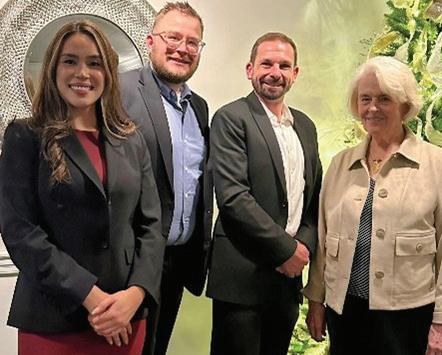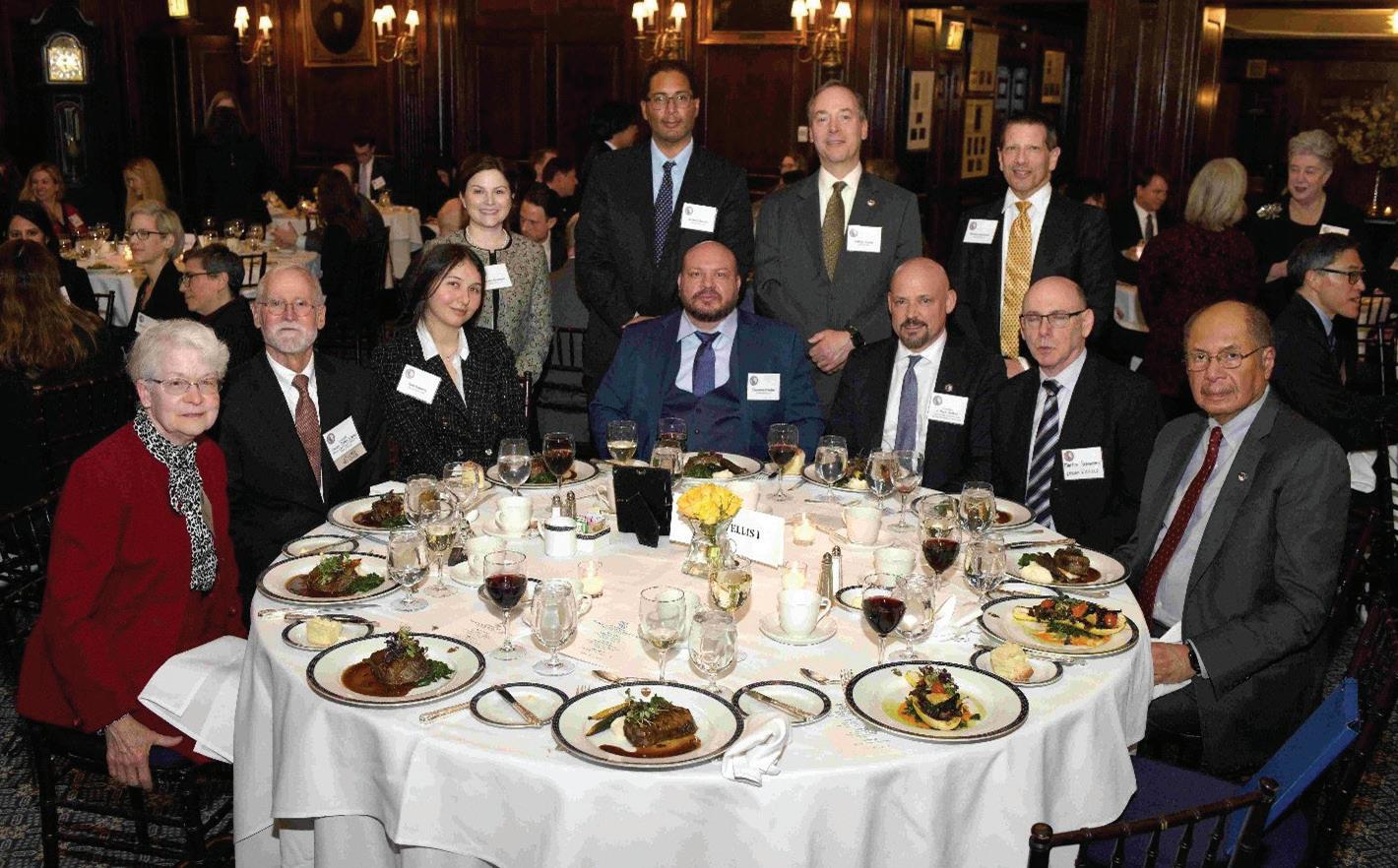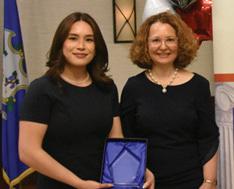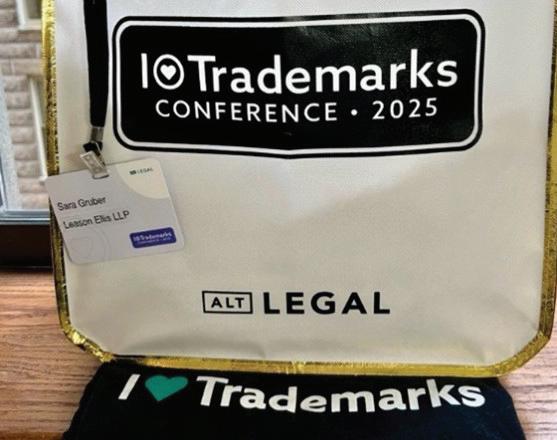
#38, SPRING/SUMMER 2025


#38, SPRING/SUMMER 2025
Also in This Issue:
Chutter Case Concludes with a Loss of Incontestable Status and Without Sanctions on Remand to the Trademark Trial and Appeal Board
Dew Process: SCOTUS Limits Trademark Profit Disgorgement in Dewberry
Sprayed Edges and Special Editions: How Multiple Versions Affect Your Book’s Copyright Application
USPTO’s Policies for Discretionary Denial are Evolving: What to Expect and How to Prepare
Have you heard the news? Leason Ellis is moving!

Mark your calendars and update your contacts because as of June 23rd, our address is changing to:
One North Lexington Avenue, Suite 1200 White Plains, New York 10601
We are excited to announce our upcoming move to our new offices at One North Lexington Avenue! Our new digs are centrally located in the heart of White Plains, the commercial hub of Westchester County, and are easily accessible by car, transit and Metro-North Railroad. With LEED Silver certification, MERV-14 rated air filtration, and convenient walkability to downtown White Plains, our new offices reflect our firm’s commitment to a bright future.
Leason Ellis receives NYSBA President’s Pro Bono Service Award
We are proud recipients of the 2025 President’s Pro Bono Service Award from the New York State Bar Association in the Small Law Firm category. This honor celebrates our firm’s dedication to serving the community and advancing access to justice. A special thank you to our entire team, with recognition to Josh Montgomery for his contributions in 2024.
Leason Ellis ranked in 2025 WTR 1000
We’re honored to be recognized once more in the 2025 edition of the World Trademark Review 1000 for our strength in trademark prosecution, strategy, enforcement, and litigation in New York. WTR praised Leason Ellis as “trustworthy and transparent,” highlighting our flexibility, adaptability, and client-first mindset. Congratulations to our ranked attorneys: Lauren Emerson, Matthew Frisbee, Michelle Levin, Yuval Marcus, Cameron Reuber, Karin Segall, and Peter Sloane.
We’re still excited about the following 2025 promotions within our ranks. Melissa Alcantara has been promoted to Partner in recognition of her outstanding achievements and dedication to client service. A trusted advisor and skilled litigator, Melissa plays a key role in helping clients protect, enforce, and grow their brands. Stefanie Garibyan was also promoted to Counsel, and Lori Cooper and Dexter Change were promoted to Senior Associates. Each brings dedication, talent, and client-focused service to their work. Congratulations to all!

By Peter S. Sloane
Under Section 15 of the U.S. Trademark Act, a claim of incontestability is available when (1) there has been no final decision adverse to the registrant’s claim of ownership or right to register the mark, (2) there is no such proceeding pending, (3) it is within one year of any five-year period of continuous and consecutive use subsequent to the date of registration, and (4) the mark has not become generic. 15 U.S. Code § 1065. Incontestability is valuable because it shields a registrant from certain challenges to the validity of a mark, notably challenges based on descriptiveness. In a decision now 50 years old, Crown Wallcovering Corp. v. the Wall Paper Mfgs. Ltd., 188 U.S.P.Q. 141 (T.T.A.B. 1975), the Trademark Trial and Appeal Board of the U.S. Patent and Trademark Office held that fraud committed in filing a Section 15 Declaration of Incontestability constituted a ground for cancellation of the registration.
More recently, in Chutter, Inc. v. Great Concepts, LLC (T.T.A.B. 2021), the Board cited Crown Wallcovering in granting a Petition to Cancel the respondent’s trademark registration on the ground of fraud. Respondent, Great Concepts, had filed a combined Declaration of Use and Incontestability under Sections 8 and 15 of the U.S. Trademark Act stating that “no proceeding involving said rights pending and not disposed of in either the U.S. Patent and Trademark Office or the courts exists,” even though a prior cancellation proceeding and civil action were then pending against its right to register and use the mark at issue. Finding that the respondent had acted with “reckless disregard” when signing and filing the declaration, the Board concluded that it had the specific intent to deceive the USPTO and it therefore granted the Petition to Cancel its registration on the ground of fraud.
On appeal, in a split 2-1 decision, the United States Court of Appeals for the Federal Circuit reversed and remanded the Board’s decision. Great Concepts, LLC v. Chutter, Inc., 90 F4 1333 (Fed. Cir. 2024). The Federal Circuit concluded that Section 14 of the U.S Trademark Act, which allows a third party to seek cancellation of a registration when the “registration was obtained fraudulently,” does not authorize cancellation of a registration when the incontestable status of that mark is “obtained fraudulently” (emphasis added). Even though the Declaration of Use and the Declaration of Incontestability were combined and filed together, the Court concluded that fraud in claiming the latter was not tantamount to claiming fraud in the former, and that a Section 14 cancellation of a registration is not an available remedy for a fraudulent Section 15 Declaration.
On remand, in a non-precedential decision, the Board removed the incontestable status of the registration at issue, but it declined to refer the conduct of respondent’s attorney, who signed and filed the declaration, to the Director of the Office of Enrollment and Discipline “given the passage of time and the specific circumstances of [the] case,” citing Chutter Inc. v Great Concept, LLC (T.T.A.B. February 25, 2025). The Board referred the registration at issue to the USPTO’s Post Registration Division for withdrawal of the Notice of Acknowledgement of the respondent’s Section 15 declaration and stated that the registration file should include an indication that the Notice of Acknowledgement has been withdrawn pursuant to its order.
As some commentators have noted, it is conceivable that Great Concepts may file a new Section 15 Declaration when the conditions have been met (e.g., there is no proceeding involving said rights pending in the USPTO or in a court and not finally disposed of). Indeed, as Circuit Judge Reyna wrote in his dissent, the majority opinion means that “the maximum penalty for fraud committed to obtain incontestability is losing incontestability, the very thing the registrant was not entitled to ab initio.” This mere resetting of the status quo arguably deprives the USPTO of a means to sanction fraudulent conduct committed upon it and risks misinforming the public about the incontestable status of registrations. It also unsettles 50 years of case law and the understanding among practitioners that fraud in claiming incontestability risked the validity of the registration.
• As stated in the majority opinion, “[l]oss of incontestable status is not nothing; it means that, if challenged, a mark owner will have a harder time preserving the validity of its registered mark.” It is worth remembering that a litigant in an infringement suit is allowed to raise fraud in obtaining incontestability as a defense and reduce the evidentiary weight of incontestability based upon any such fraud.
• Even though the Board declined to sanction the attorney who signed and filed the Declaration of Incontestability, attorneys should still be wary of signing declarations asserting claims on behalf of their clients. If signing such declarations, counsel should independently verify the facts and/or obtain written confirmation from their clients to support the claims.
• The Chutter case illustrates that there are notable differences between trademark and patent law. As the dissenting opinion states, “[i]n the patent context, ‘inequitable conduct regarding any single claim renders the entire patent unenforceable’ and may further endanger the patentee’s rights in related patents,” citing Therasense, Inc. v. Becton, Dickinson & Co., 649 F.3d 1276, 1288 (Fed. Cir. 2011).


By Tatsuya Adachi
The U.S. Supreme Court held unanimously in Dewberry Group, Inc. v. Dewberry Engineers Inc. (Case No. 23900) that an award of “defendant’s profits” under federal trademark law is limited to the profits of the named defendant and excludes those of its non-defendant corporate affiliates. That is so even where, as here, the defendant has engaged in willful infringement and yet has generated—at least as a matter of accounting, to the great benefit of its corporate affiliates—no profits for itself whatsoever.
Dewberry Engineers, the plaintiff, provides real estate development services to other businesses nationally. It owns a registration for the mark “Dewberry” for real estate-related services. Dewberry Group, the defendant, also provides real estate-related services. This case arose from Dewberry Group’s repudiation of a settlement agreement arising from a trademark infringement lawsuit Dewberry Engineers filed against it in 2007. The U.S. District Court for the Eastern District of Virginia found Dewberry Group’s conduct here to be “intentional, willful, and in bad faith,” in an opinion that Justice Elena Kagan, who authored the majority opinion for the Supreme Court, characterized as “scathing.”
As to damages, although Dewberry Group itself generates no profits, it is part and parcel of a distributed yet unified business enterprise that is profitable. Dewberry Group provides operational services exclusively to approximately 30 of its own corporate affiliates. Dewberry Group and the affiliates share the same owner. Each affiliate owns real property for the purpose of generating rental income. None of the affiliates has any employees. During the relevant period of infringement, the affiliates combined to generate $43 million in profits, and the District Court awarded that amount to Dewberry Engineers to reflect the “economic realities” of Dewberry Group’s financial arrangement with its affiliates, the Fourth Circuit Court of Appeals affirmed.
In February, the Supreme Court vacated that award and remanded the case for further proceedings in the U.S. District Court. Citing the principle of corporate separateness and taking a textualist approach to the Lanham Act’s damages provision, the Supreme Court found no basis for the District Court’s damages award. It found that Section 1117(a) of the Lanham Act provides for an award only of “defendant’s profits,” and the District Court’s decision amounted to an award of non-defendant’s profits.
The Supreme Court expressly declined to decide whether, on other theories, a court may award a prevailing trademark plaintiff the profits of the named defendant’s non-defendant affiliates, including under the “just sum” provision of the Lanham Act, which empowers a district court to “enter judgment for such sum as the court shall find to be just, according to the circumstances,” notwithstanding the quantum of the named defendant’s profits. The Court also did not consider whether Dewberry Engineers’ award could be sustained on a corporate veil-piercing theory, i.e., that principles of corporate separateness should be disregarded where the purported corporate formalities are a sham. In fact, the Court expressly noted the plaintiff made no showing of veil piercing at the District Court level.
The case is now back in the U.S. District Court for the Eastern District of Virginia for a new damages award proceeding.
• Pre-suit strategy – Potential plaintiffs should work with counsel to maximize the cost-benefit of a thorough pre-suit investigation to, among other things, identify the proper defendants in a litigation. For potential defendants, this case validates the common practice of operating a single business enterprise via a network of distinct corporate affiliates. To be clear, it is not a carte blanche for obfuscation. Businesses should work closely with counsel to ensure corporate formalities are being upheld and separateness is maintained.
• Discovery – Plaintiffs should utilize narrowly-tailored discovery requests to find out where and by whom the profits generated from a trademark are held. If the trail leads to third parties other than the named defendant, the plaintiff should move to add them as defendants to conform to the evidence. Defendants should try to prevent fishing expeditions facilitated by overbroad discovery requests through timely objections and, if needed, motion practice.
• Preserving or narrowing the record for appeal – On appeal, plaintiffs may regret having abandoned certain legal theories at the trial court level, underscoring the importance of a well-developed trial court record that preserves alternative arguments on appeal. Here, Justice Kagan noted that the plaintiff did not attempt to make a showing of veil piercing at the trial court level, thereby potentially forfeiting what may have been a persuasive argument. The counterstrategy for defendants is to narrow the issues at the trial court level.


By Lauren B. Emerson
Look no further than #BookTok or #Bookstagram, and it is clear that beautiful books are having a moment. Special artwork, foil jackets and sprayed or painted edges are all the rage. Those seeking custom bindings can turn to myriad storefronts on Etsy, and book lovers can re-cover their existing libraries with covers from sites such as Juniper Books. A recent article in Publisher’s Weekly credits both the “meteoric rise of the romance and romantasy genres,” the popularity of subscription book boxes, and—of course—social media with sparking this trend. So as not to miss out, publishers (indie and traditional alike) are increasingly releasing limited editions. Notably, publishers are not only repackaging cherished best-sellers, but they are also pushing out decorative first print runs in support of buzzy new titles.
What does this mean for your copyright applications?
If you publish in print, you are required to mail in two print copies of your book along with your copyright application. It is not sufficient to upload an electronic copy unless you have only published e-versions at the time of filing.
Moreover, it is not enough to submit just any print copies; rather, to satisfy the letter of the law, you must submit copies of the “Best Edition.” If there are multiple print versions for a given title, various characteristics will inform which is “Best.” For example (and without limitation):
• Hard cover is better than paperback;
• Library binding is better than commercial;
• Trade is better than book club;
• Slip-cased is better than not;
• Special edition is better than not;
• Limited edition is better than trade; and
• Illustrated is better than unillustrated.
Generally speaking, the highest quality edition will be considered “Best” and certain criteria carry greater weight; for example, paper quality is more important than the nature of the binding. Nuances aside, if you have published a special edition of a particular title by the time you apply to register your copyright, there is a good chance that it is the “Best Edition.” If this raises concerns, it is possible to seek special relief from this requirement by petitioning the Copyright Office.
Even if you have already registered your book by the time you release a special edition, there may be reasons to register the new version, too. For example, if you have added bonus chapters, illustrations or annotations, it may be prudent to file to ensure that those new aspects are covered.
If you have questions about copyright registration practices and strategy, you should seek the advice of a qualified professional. Our team is here to help.


By Roland Rivera-Santiago
In instances where a patent challenger submits a petition to the United States Patent and Trademark Office (USPTO) for inter partes review (IPR) or post-grant review (PGR) of a patent and there is parallel litigation involving the same patent, the Director of the USPTO, and, by delegation, the Patent Trial and Appeal Board (PTAB) administrative patent judges (“Judges”) have discretionary authority to deny institution of the petition.
Until recently, this discretionary denial authority was exercised according to the USPTO’s June 22, 2022 Interim Procedure for Discretionary Denials (the “2022 Guidance”). On February 28, 2025, however, the USPTO rescinded the 2022 Guidance. Since then, the USPTO has issued multiple memoranda aimed at clarifying the USPTO policies and procedures for discretionary denials going forward, including a March 24, 2025 memo on the impact of the recission (the “2025 Guidance”), a March 26, 2025 Interim Processes for PTAB Workload Management (the “2025 Interim Processes”), and answers to Frequently Asked Questions released April 25, 2025 (the “FAQ”). Nevertheless, discretionary denial practice at the PTAB remains unsettled.
By way of background, the 2022 Guidance, colloquially known as the Fintiv memo or Fintiv guidance, heavily referenced a 2020 PTAB ruling that detailed a non-limiting 6-factor test for its APJs to apply when deciding whether to discretionarily deny institution of an IPR or PGR proceeding based on the existence of parallel litigation, see Apple, Inc. v. Fintiv, Inc., IPR2020-00019, Paper No. 11, *5-16 (PTAB, March 20, 2020). The factors to consider in this test were the following:
1. Whether a stay of the litigation exists or is likely to be granted if a PTAB proceeding is instituted;
2. Proximity of the district court’s trial date to the PTAB’s projected statutory deadline;
3. Investment in the parallel proceeding by the district court and the parties to the litigation;
4. Overlap between issues raised in the IPR petition and in the parallel proceeding;
5. Whether the petitioner and the defendant in the parallel proceeding are the same party; and
6. Other circumstances that impact the PTAB’s exercise of discretion, including the merits.
The 2020 Fintiv decision led to a significant increase in discretionary denials by the PTAB in 2020 and 2021, which was controversial. For example, companies accused of patent infringement or otherwise wishing to challenge patents at the PTAB, were critical of discretionary denials for cutting off access to the PTAB when infringement suits were filed in venues that scheduled trials quickly, such as the United States International Trade Commission (the “ITC”) and the Eastern and Western Districts of Texas.
The USPTO released the 2022 Guidance after receiving over 800 public comments on discretionary denials after Fintiv and the proposal of a bill in Congress seeking to ban them outright. The 2022 Guidance detailed circumstances in which the USPTO opined that it would be improper to deny institution of IPRs, for example, when the parallel litigation was an ITC proceeding, or when a party had stipulated to not pursue similar arguments to those made in the IPR petition in another forum. Notably the 2022 Guidance explained that the PTAB would not deny institution of an IPR or PGR in the following circumstances:
• When the parallel proceeding is before the ITC.
• When the petitioner presented “compelling evidence of unpatentability.”
• When the petitioner filed a “Sotera stipulation” in the parallel District Court proceeding stipulating that petitioner would not, in that proceeding, pursue the invalidity grounds that are raised in, or could reasonably have been raised, in an instituted IPR or PGR petition.
Overall, the 2022 Guidance was viewed by PTAB practitioners as curtailing the number of discretionary denials issued by the PTAB.
The 2025 Guidance confirms a return of the pre-2022 Guidance discretionary denial framework, and it means that discretionary denials of IPR proceedings will become more common. The 2025 Guidance also expressly identifies notable departures from the 2022 Guidance including that:
• The Fintiv discretionary denial framework applies to PTAB petitions with parallel ITC proceedings;
• Compelling merits are not dispositive, and the Fintiv factors are considered as part of a balanced assessment of all relevant circumstances of record, including the strength on the merits;
• A petitioner’s Sotera stipulation would not be dispositive, but instead would be considered highly relevant and analyzed under the Fintiv factors; and
• The PTAB will consider any evidence of record bearing on whether the parallel District Court’s trial date or ITC’s final determination date precedes or follows the PTAB’s deadline to render a final written decision, and that the PTAB will be less likely to deny institution where the PTAB’s final written decision would come first.
The 2025 Interim Processes for PTAB Workload Management establish a bifurcated procedure in which (i) the USPTO Director in consultation with three PTAB judges will determine first whether to discretionarily deny institution of an IPR or PGR petition, and (ii) if the petition for institution is not discretionarily denied, a three PTAB judge panel will decide whether to institute proceedings on the merits and non-discretionary statutory considerations according to established USPTO procedure. Additionally, parties are now permitted to file separate briefings for or against discretionary denial that may address all relevant considerations, such as the factors set forth in Fintiv and other PTAB precedents, and non-exclusive topics further enumerated in the 2025 Interim Processes:
• Whether the PTAB or another forum has already adjudicated the validity or patentability of the challenged patent claims;
• Whether there have been changes in the law or new judicial precedents issued since issuance of the claims that may affect patentability;
• The strength of the unpatentability challenge;
• The extent of the petition’s reliance on expert testimony;
• Settled expectations of the parties, such as the length of time the claims have been in force;
• Compelling economic, public health, or national security interests; and
• Any other considerations bearing on the Director’s discretion.
Notably, the 2025 Interim Processes also provides that the Director will consider factors such as statutory deadlines for resolving proceedings and PTAB workloads when making a decision on whether to deny institution.
The FAQ fills out some procedural details for the bifurcated review process, including the timing for parties to submit discretionary denial briefing and related stipulations, the allocation of responsibilities among the Director and PTAB Judge panels, briefing requirements, and processes for requesting rehearing of discretionary and merits-based denials.
Going forward, the expectation among many PTAB practitioners is that discretionary denials will increase. A further consequence of the 2025 Guidance is that patent infringement suits might become more common in venues known to schedule trial dates quickly, such as the ITC, as patent owners seek to limit the risk of a patent challenge at the PTAB being instituted. Patent challengers, on the other hand, are more likely to file IPR or PGR petitions well before the statutory one-year deadline imposed by the America Invents Act and are incentivized to consider “Sotera” stipulations as part of a strategy to limit discretionary denials. Another possible consequence of the current discretionary denial framework could be a decrease in stays of those parallel litigations, as district court judges might expect their cases to take priority. Ultimately, the 2025 Guidance signals a return to the pre-2022 framework in which the USPTO Director has broad discretionary denial authority and, concomitantly, increased uncertainty as to how those discretionary denials will be decided.
• USPTO guidance documents – legal memoranda setting forth the USPTO’s policies on issues not otherwise defined by federal statutes or administrative regulations-are subject to change with shifts in USPTO policy, sometimes on short notice.
• The 2025 Guidance signals the USPTO’s clear intent to return to the policies put into place before the 2022 Guidance and provide the Director and PTAB Judges more flexibility when applying the discretionary denial framework of Apple, Inc. v. Fintiv, Inc.
• The 2025 Interim Processes are purportedly temporary and at least partly dependent on the workload of the PTAB. The PTAB workload is likely to remain a factor for years to come, considering the current administration’s initiatives to reduce the size of government agencies impacting the USPTO.

• The USPTO Director’s broad authority to deny institution as implemented in the 2025 Guidance and 2025 Interim Processes, including for reasons unrelated to the underlying patent or parallel litigation (e.g., PTAB workload), further increases the concern that discretionary denials will be decided inconsistently.
• Both patent owners and challengers should be prepared to adjust their IPR and PGR strategies as the 2025 Guidance and 2025 Interim Procedures are implemented and tested and boundaries established. At a minimum, the cost of IPR and PGR proceedings is likely to increase for all parties due to the new Discretionary Denial briefing requirements and stringent deadlines.
Associate Audrey Trace Attends First Annual “Distinguished IP Practitioner’s Dinner”
On December 11, 2024, Associate Audrey Trace attended the first ever Distinguished IP Practitioner’s Dinner hosted by the Judge Arterton Inn of Court in concert with the Connecticut Intellectual Property Law Association (“CIPLA”). Trace is the current Vice President of the Connecticut-based Inn of Court.

Audrey Trace at Distinguished IP Practitioner’s Dinner
Westchester Women’s Bar Association’s Holiday Party Sponsored by Leason Ellis
Melissa Alcantara and Elizabeth Barnhard attended the annual holiday party of the Westchester Women’s Bar Association (WWBA) on December 12, 2024. Elizabeth Barnhard is a Director on the Board of the WWBA.

and Elizabeth
Leason Ellis Attends the Hon. William C. Conner Inn of Court 17th Annual Reception & Dinner in Honor of the Federal Judiciary
On January 22, 2025, Leason Ellis proudly attended the Hon. William C. Conner Inn of Court’s 17th Annual Reception & Dinner at NYC’s Union League Club, celebrating the contributions of the federal judiciary. Members of the firm in attendance included Partners Mel Garner, Lauren Emerson, Rob Isackson, Cameron Reuber, Henry Gabathuler, and Jordan Garner, as well as Associates Jarryd Werts, Vera Glonina, Roland Rivera-Santiago, and Audrey Trace.

Leason Ellis Team Members Lauren Emerson (back left), Jordan Garner (back second-left), Rob Isackson (back right), Vera Glonina (front third-left), Cameron Reuber (front center), and Mel Garner (front right) Attend Judiciary Dinner
Partner Matt Frisbee Attends WTR Brand Strategy Summit in London
In early March, Leason Ellis Partner Matt Frisbee participated in the World Trademark Review Brand Strategy Summit Europe, held at BMA House in London. The two-day event focused on strategies for safeguarding brand integrity.
On March 5, 2025, Leason Ellis Partner Karin Segall participated in a panel discussion titled “IP In Action” at Pace Law School. The event included professionals from diverse intellectual property backgrounds and focused on potential career paths in IP law, as well as the opportunities and challenges facing aspiring IP legal professionals.
Karin Segall (Second from Right) Participates in Pace Law Panel Discussion

Trademark Associate Audrey Trace Stays Active in New York and Connecticut Legal Organizations
Leason Ellis Associate Audrey Trace remains actively involved in legal organizations in New York and Connecticut. She serves as co-chair of both the New York Intellectual Property Law Association (NYIPLA) Young Lawyers Section and the Connecticut Bar Association (CBA) Young Lawyers and Women in Law Committees. In February 2025, Audrey attended the CBA’s Diversity Dinner. On March 6, she co-presented the Ladder Award to Connecticut Attorney Kimberly Jacobsen at the CBA’s Pathways to Leadership for Women Lawyers Dinner. Audrey also participated in the NYIPLA Young Lawyers Happy Hour in Manhattan in March.

On March 15, Leason Ellis Partner Ralph Crispino, along with Associates Roland Rivera-Santiago and Josh Montgomery, volunteered their time and expertise as judges at the 2025 Regeneron Westchester Science and Engineering Fair (WESEF) for high school students. Their participation reflects the firm’s commitment to STEM education through the evaluation of aspiring scientists’ projects from Westchester, Putnam, and Sullivan counties.
On March 18, 2025, Leason Ellis Associate Sara Gruber attended the I ♥ Trademarks Conference (https:// www.altlegal.com/i-heart-trademarks-2025/) in New York City, hosted by Alt Legal. The event showcased educational sessions aimed at trademark professionals, covering topics from social media ethics to international trademark challenges.

Sara’s Swag Bag from I ♥ Trademarks Conference
Leason Ellis Attorneys Attend INTA Event Titled “The Business of Trade Secrets: Navigating the Challenges and Opportunities in the Ever-Changing World of AI” in NYC
On March 19-20, 2025, Leason Ellis Partner Peter S. Sloane and Associate Vera Glonina attended INTA’s gathering titled “The Business of Trade Secrets: Navigating the Challenges and Opportunities in the EverChanging World of AI.” The event included a New York INTA Pre-Annual Meeting Reception, which Partner Yuval Marcus also attended.

Leason Ellis was well-represented at the 103rd Annual Dinner in Honor of the Federal Judiciary on March 21, 2025, held at the New York Hilton Midtown Hotel. Attendees from our firm included Partners Rob Isackson, Lauren Emerson, Peter Sloane, Mel Garner, and Jordan Garner, along with Associates Jarryd Werts, Tatsuya Adachi, Kevin Wallace, Audrey Trace, Dexter Chang, Sara Gruber, and Catherine Kim. Federal Circuit Judge Jimmie V. Reyna was presented with the 23rd Annual Outstanding Public Service Award.

From Left: Jarryd Werts, Tatsuya Adachi, Kevin Wallace, Dylan Harriger, Audrey Trace, Sara Gruber, and Catherine Kim attend Judges’ Dinner Events
On March 31, 2025, Leason Ellis Associate, VLA Associate Board Member, and former professional singer Tatsuya Adachi led a workshop on the key legal issues in the photography business for VLA titled “Legal Issues in Photography: Copyright, Contracts, and AI.” The session—designed for photographers and visual artists of all disciplines—covered essential topics such as copyright law, contracts, privacy rights, social media, and the impact of AI on photography.
Attorney Elizabeth Barnhard Secures Leadership Role in Westchester Women’s Bar Association
Leason Ellis Attorney Elizabeth Barnhard was reelected as a Director at the Westchester Women’s Bar Association meeting on April 2, 2025. Congratulations Elizabeth!
Leason Ellis Partner Peter Sloane Joins Ninth Judicial District Mediator Roster
Peter Sloane has been accepted to join as a mediator on the roster of mediators for the Ninth Judicial District in Westchester, Putnam, Dutchess, Rockland, and Orange counties in New York. He has also completed the first step in becoming a Florida Supreme Court Certified Circuit Mediator by completing the 40-hour Circuit Mediation Training Program with Mediation Training Academy.
Leason Ellis Delegation Set for INTA Annual Meeting in San Diego
Several partners and associates represented the firm at the International Trademark Association (INTA) Annual Meeting, from May 17 to May 21, 2025, in San Diego, California. Our team members in attendance included Partners Karin Segall, Peter Sloane, Lauren Emerson, Matt Frisbee, Yuval Marcus, and Melissa Alcantara, alongside Associates Audrey Trace and Vera Glonina. INTA remains the largest annual gathering of IP professionals and will focus on “The Business of IP.”
Leason Ellis Partner Peter Sloane to Lead Schedule A Litigation Working Group
Peter Sloane has been assigned to lead a working group on Schedule A litigations for the U.S. Trademark Law & Litigation Committee of the Intellectual Property Owners Association (IPO). “Schedule A” cases are so named because the defendants, typically alleged counterfeiters, are identified in a schedule often filed under seal, rather than named in the caption to the complaint, to avoid tipping them off to the case filing.
Leason Ellis Softball Team Returns to Action
Following its runner-up finish in the 2024 season, our Monsters co-ed softball team-comprised of firm partners, associates, staff, friends, and family— is back in action every Tuesday evening through late July. Go Monsters!
We’re always thinking and know you are too, so we welcome your comments, questions, and suggestions. As a firm dedicated to the application of keen insight in intellectual property law and business, our goal is to make The Newtonian a useful periodical that you read and share. Reach us at inquiries@leasonellis.com.
Clients engage Leason Ellis to obtain outstanding legal counsel to protect and enforce their intellectual property rights. Our specialized practice area excellence comes from a keen appreciation for inventiveness, creativity, branding, a profound understanding of the law, and a powerful commitment to using IP to help our clients achieve their business objectives. Learn more about Leason Ellis at leasonellis.com
Leason Ellis LLP
One Barker Avenue
White Plains, New York 10601
T 914.288.0022
Attorney Advertising